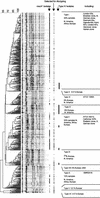mecA gene is widely disseminated in Staphylococcus aureus population
- PMID: 12409360
- PMCID: PMC139644
- DOI: 10.1128/JCM.40.11.3970-3975.2002
mecA gene is widely disseminated in Staphylococcus aureus population
Abstract
Methicillin-resistant Staphylococcus aureus (MRSA) is one of the most important causes of hospital infections worldwide. High-level resistance to methicillin is caused by the mecA gene, which encodes an alternative penicillin-binding protein, PBP 2a. To determine the clonal relationships between methicillin-susceptible S. aureus (MSSA) and MRSA, we typed 1,069 S. aureus isolates (493 MSSA isolates and 576 MRSA isolates), collected mainly in North American and European hospitals between the 1960s and the year 2000, using pulsed-field gel electrophoresis and ribotyping. Of 10 widespread S. aureus lineages recognized, 8 had corresponding mecA-positive strains. Multiresistant MRSA strains are found in hospitals worldwide, while unrelated and more susceptible strains represent less than 1% of the MRSA population. This supports the hypothesis that horizontal transfer plays an important role in the dissemination of the mecA gene in the S. aureus population.
Figures



References
-
- Archer, G. L., and D. M. Niemeyer. 1994. Origin and evolution of DNA associated with resistance to methicillin in staphylococci. Trends Microbiol. 2:343-347. - PubMed
-
- Centers for Disease Control and Prevention. 1999. Four pediatric deaths from community acquired methicillin-resistant S. aureus—Minnesota and North Dakota, 1997-1999. Morb. Mortal. Wkly. Rep. 48:707-710. - PubMed
MeSH terms
Substances
LinkOut - more resources
Full Text Sources
Other Literature Sources
Medical
Molecular Biology Databases
Research Materials
Miscellaneous

